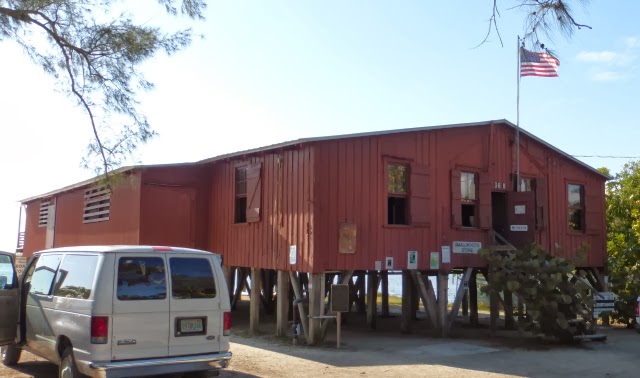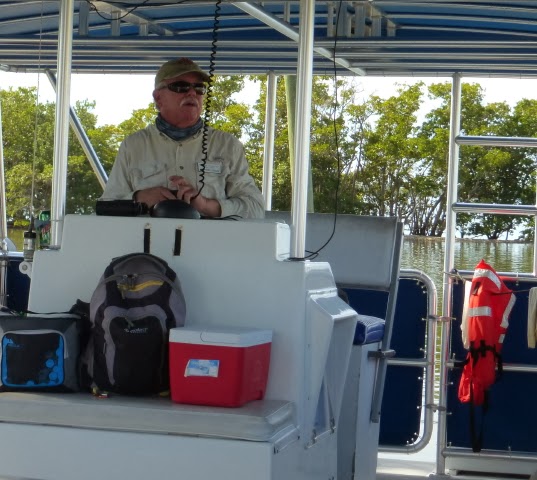We had planned on
staying at one of the RV spots at Flamingo Campground in the National
Park. We called ahead & found out
that only dry camping was available & decided to stay in a commercial RV
park for three nights in Homestead ,
FL.
After setting up
camp, Dan did internet research & we headed to Marios Family Restaurant for
Cuban food. We had Spanish bean soup,
croquette, fried green plantains w/garlic sauce, congris, yuca, filletillo
churrasco, & pan con bistec; highly recommended! From there we tried to shop at Walmart - the
store was way too busy. So we just
fueled the Toad & headed back to the RV thru more bad traffic.
Sunday morning it
was off to Everglades National Park to arrive at the Ernest F. Coe Visitor
Center
After the Amble we
left the park for lunch at the Gator Grill where you can get gator burgers, gator
tacos, gator wraps, etc. We stuck to
some excellent soup. On the way back to
the park we almost collided w/three ATVs traveling at high speed coming at us
in our lane. Turns out illegal use of
ATVs is a big problem on this side of the park because the open area &
minimal law enforcement. In fact, in the
afternoon we saw dozens of ATVs being unloaded from trailers & pick-ups -
many already being raced up & down the road & beside the road.
Back at Royal Palm
we walked the Gumbo Limbo Trail before joining the docent led tour of the Nike
Missile Battery located in the middle of the park. Another excellent event. Half the tour is a "history lesson"
starting w/the Yalta Conference, progressing thru Berlin
blockade, Russia getting the
A-bomb, U-2 incident, Bay of Pigs , &
ending w/the Cuban Missile Crisis. Turns
out until the Crisis there were no plans for Nike missile defensive except for
northern states & Alaska Florida 

Monday, 20JAN, morning
we headed to the Shark Valley Visitor
Center located in the northeast corner
of the Everglades
National Park
Note - if you ever
go to the Everglades
National Park
Lunch was at Miccosuccee
Cafe, then it was back to the RV. The
Miccosuccee say they are one of two remaining Native Americans in the Everglades (the other being Seminoles). But we were told on occasion that the
Miccosuccee are Seminoles, but with some sort of political difference? In our RV'ing we have tried several Native
American eating establishments & we have always been disappointed. We never get "native" cuisine. Note - fry bread is not true Native American
cuisine! It was what they created when
they were forced to reservations & provided with surplus food by the
government (ie wheat, flour, butter, etc).
The Miccosuccee was also a disappointment. In fact their menu pride fully announces
their favorite foods as burgers, fries, grits & soft drinks?
Tuesday morning we
(ie Dan) decided to head to the Flamingo Campground. This campground is one of the few in the
National Park Service that has dedicated RV spots, some with electricity. There is a reservation system for these
spots, but it is booked months in advance.
However the Park Service sets aside some for first come/first served so
we were keeping our fingers crossed for electricity. Driving there was in the rain & our dash
defroster didn't work even though most of the AC was replaced last month in Houma , LA. Tampa
Unfortunately we
could only get dry camping in Flamingo: but since a cold front was forecasted
for next few days electricity for AC wouldn't be an issue. We can use propane if necessary for heat. After setting up camp we were very surprised
to discover our house batteries were almost "dead". In fact they wouldn't even start the
generator! We restarted the RV so we
could start the generator & charge batteries.
Then we headed to
the Flaming Visitor Center
Wednesday morning we
drove to Nine Mile Pond for the 8AM canoe paddle led by a Ranger. This is another great free activity in the
National Park Service - in fact they provide canoes, paddles, seat cushions
& life jackets! We assumed the
canoeing would be on open water but most it was through mangrove clusters. Which meant many hard turns in very tight
quarters(you actually had to duck to get through some of the mangrove tunnels). As a result there many collisions with mangrove
roots & other canoeists. Tempers
warmed-up every now & then, but it was an enjoyable three hours on the
water. One of the other canoeists
mentioned that at another National Park the couples were encouraged to paddle
w/someone other than their partner & it was less stressful?
We wanted to
participate in other Ranger led activities but Dan needed to address our house
battery issue. He spent a couple of
hours disconnecting the four batteries & cleaning each terminal & each cable
connection. You would think with four
batteries there would only be eight cables (two for each battery). But because there are multiple electric loads
& the generator, there were fourteen different connecting cables. Dan did find signs of corrosion & cable
wastage, he cleaned the terminals & connections the best he could trying
not to damage/break the wasted cable connections.
Meanwhile Corrie
went to take a shower but discovered no hot water. Turns out all the other camp grounds have
solar heated water but not the RV section?
After successfully taking hot showers it was off to the shoreline for a
walkabout with Gumbo. No one felt like
cooking dinner so we got take-out from the cafe at the Flamingo Visitor
Center 

Thursday morning,
23JAN, we awoke to find the house batteries dead once again, looks like we will
be buying four new house batteries soon.
After breaking camp we hit the road for the last visitor center in the Everglades National Park
- Gulf Coast
Visitor Center
located in Everglades City ,
FL.
Most of our drive
was due west on state road 41 (aka Tamiami Trail). This is a very beautiful drive but
unfortunately the road is one of the biggest problems for the National
Park. When it was built no one realized
they were building a "dam" basically extending across Florida from the Gulf of Mexico to Miami
depriving the Everglades of vital water from Lake Okeechobee
Trivia - what does
Tamiami mean?
During our drive we
stopped at the Oasis Visitor Center
& the Big Cypress Swamp
Visitor Center Big
Cypress Swamp
Visitor Center
Our RV park was
located on Cokoloskee Island definitely at the end of the road, & a small
coastal town Florida Cokoloskee Island Gulf Coast Visitor Center
for Everglades National Park 

Friday morning,
24JAN, we discovered that our major credit card was now wrapped-up in the
Target problem. So now we have a block
on our card & await the arrival of our new card. Since it was a little windy we decided rather
than go on a boat tour we would use the Toad to drive some of the dirt roads in
the Big Cypress National Preserve.
We were driving on
Birdon Road for about twenty minutes when lo-and-behold we had a full grown
Florida Panther walk across the road about a quarter mile in front of us!!! Although
we were not terribly close we could tell from the profile that it was a definitely
a rare Florida Panther. We slowly drove
up to the spot on the road that we thought it had traveled but it had already
disappeared into the underbrush. While
it was not an up close & personal look, we were more excited at having
glimpsed it in the wild than any animal we ever saw in a zoo:)
After driving the
Birdon & Turner River Roads we then went to the Loop Road Big Cypress
Swamp Welcome
Center
When we got back to Everglades City 

Saturday morning,
25JAN, we drove to the Kirby
Storter Roadside
Park
Turns out the
elevation of the ground drops a little over a foot by the end of the
boardwalk. This apparently small change
in elevation results in varying lengths of "wetness" & four distinct
environments. The front of the boardwalk
is dry eight months of year & is saw grass prairie; by the end of boardwalk
is wet all year & is a cypress swamp.
After the tour we
headed to the town Marco
Island Marco Island
was a sleepy little coastal Florida
Upon return to the
RV Dan visited the Smallwood Store & Museum located at the very end of Chokoloskee Island Chokoloskee
Island has been called
one of Florida 



Sunday morning we
headed to the Everglades National Park "Gulf Coast Visitor Center 







After returning to
the RV Corrie decided to take a break, while Dan & Gumbo headed to Fakahatchee Strand
Preserve State
Park to see one of the few remaining old growth Cypress Cypress




































































